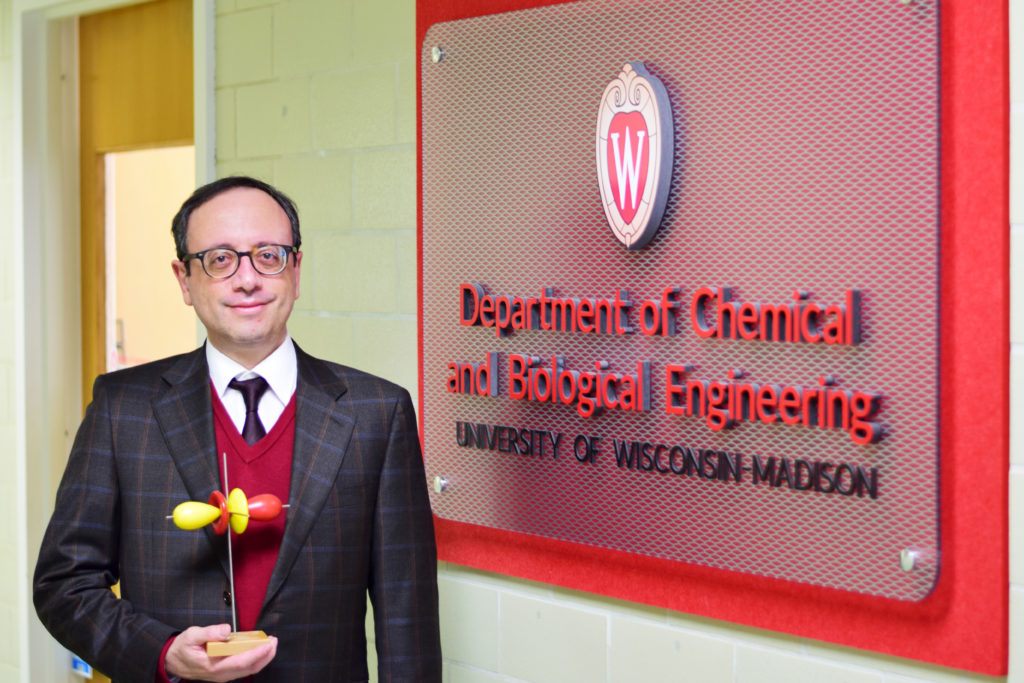
Catalysis, the process of accelerating the rate of chemical reactions, has been a focal point of scientific research for many decades. In the 21st century, catalysis continues to contribute to the manufacturing of 90% of the products we encounter daily, from modified foods, to gas for your car, to the majority of manufactured consumer products. How else can it contribute to a better future?
One UW-Madison faculty member of the chemical and biological engineering department, Professor Manos Mavrikakis, discussed with me the potential for his work on catalysis to contribute to an environmentally friendly world. His research team previously developed and now uses a methodology based on microkinetic and molecular modeling. During this process, they work iteratively with the elementary steps of a chemical reaction – calculating from quantum mechanics binding energies of reactants, products, and reaction intermediates. From this information, they can infer the decoration and shape of the catalyst’s active sites when the reaction is taking place. Their models can help decipher what separates a good catalyst from a bad one for a given reaction and eventually develop better performing catalysts. This process lends itself toward improving the efficiency of catalysis in specific reactions, like electrochemical and thermal energy-generating reactions.
In terms of electrochemical reactions, Mavrikakis discussed the potential for these electrocatalysts in relation to renewable energy. “As electricity from renewable sources becomes cheaper, people are trying to use it to drive reactions,” says Mavrikakis. “Catalysis for efficient energy production is at the core of catalytic systems that we choose to work on.” As the efficiency of electrochemical reactions is increased, the ability of electrocatalysis to become a sustainable process fueled by renewable energy will increase as well.
Besides electrocatalysis, Mavrikakis also noted the potential for thermal energy-related catalysis in working towards a greener future by reducing the harmful effects of greenhouse gases like carbon dioxide and methane. “If we can capture CO2 where it’s being produced and transform it into a useful liquid such as methanol… we can have an impact on the global community,” says Mavrikakis. Using catalysis will improve the process of liquifying carbon dioxide and turning it into a fuel while simultaneously reducing the effects of greenhouse gases in the atmosphere.
As for where his research will end up, Mavrikakis believes we will continue to see the effects of the research conducted at UW-Madison for decades to come. “We are working as a community… I would argue that it’s a long-term type of work,” says Mavrikakis. “At the University, the chemical engineering department has been a post of excellence for 70 or more years now.” Mavrikakis credits his colleague, celebrated catalysis researcher Professor James Dumesic, along with scholars such as late Profs. Robert Bird, Warren Stewart, Edwin Lightfoot, and Olaf Hougen for the success at UW-Madison in chemical engineering.
Mavrikakis explains that UW-Madison’s chemical engineering department can “generate new technologies and jobs that feed back into the economy of Wisconsin.” However, he believes that his work in catalysis in the future of renewable energy and reduction of the effects of climate change go beyond Madison and even the state of Wisconsin. His research has a worldwide scope, and as he explains, “if other countries don’t do it too, it doesn’t help. The entire humankind needs to work together and commit to controlling climate change.” Catalysis is already an important part of our everyday lives, and as we continue to improve efficiency in processes like electrocatalysis and thermal catalysis, it can become an even bigger part of improving our world.
Photograph by Hridyesh Tewani
